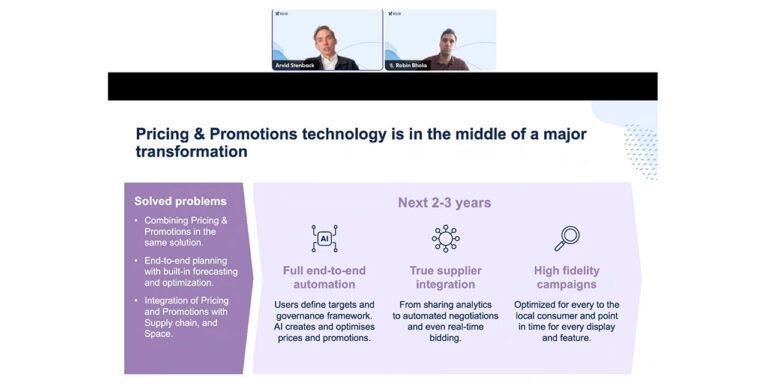Markdowns cost retailers billions. One survey put the figure at $300Bn in 2018, or 12% of total sales — and that figure is for non-grocery retailers in the US alone! So why do we even mark products down? Because they’re essential in the world of retail, whether we like them or not.
The first person to figure out exactly how much customers want AND calculate the perfect price to sell out stock before it expires or goes out of fashion? That person will be immortalized in retail lore, but we mere mortals must resort to markdowns to get rid of our excess stock.
Shouldn’t a forecasting and replenishment solution mean you need fewer markdowns?
Retailers who have optimized their store replenishment to more accurately match supply to demand can achieve up to 30% reduction in markdown and spoilage costs — but cannot eliminate markdowns entirely. What then are the factors that cause markdown situations?
For grocers especially, the most common cause for markdowns is poor tracking of their perishable products’ “best-before” dates, which increases the risk of fresh spoilage. Markdowns are also widely used during assortment changes in which old lines must be cleared to make room for the new. A third common cause is seasonal promotions, which force retailers to clear their stock before the season ends.
Obviously, your primary goal should be organizing your supply chain to minimize markdowns as much as possible. The next step, though, is to finetune your response to markdowns as they arise in order to strengthen your position in the market.
The Point of Markdowns: Maximizing Margin and Avoiding Excess Stock
By now, we’ve hopefully accepted that nobody can eradicate markdowns entirely. However, when these situations do occur, retailers must have a thoughtful strategy in place to achieve their markdown goals: maximizing margin and avoiding excess stock.
Step 1 – Identification
The first and most important step in this strategy is to identify which products need to be marked down. Look for products that aren’t performing as planned, are due to spoil or are about to be terminated because of merchandising or planogram changes. Of course, doing this manually for tens of thousands of products isn’t feasible for any planner. That’s why the process usually starts by looking at data: is the projected stock at the end of a product’s lifecycle too high? Is the product’s sales performance in line with targets and budgets? Is the product’s days of supply too high?
Step 2 – Defining Rules
As you identify the products in need of markdown, you should also define the rules you will use during the markdown process. The most efficient approach is to limit the markdown optimization result based on any of the following:
- Price grid, e.g. allowing only prices that end with .90 cents
- Rounding rules, i.e. always round to the nearest allowed price/discount
- Desired output, i.e. in terms of price or percentage
- Optimization level, i.e. requiring the same price for a product across all stores vs. allowing different pricing per location
Step 3 – Price Elasticity
Different products and product categories have different price elasticities. Through analyzing your past sales performance, you are able to understand how a product in a specific location reacts to a price change in order to avoid being too heavy- or light-handed in your markdowns.
Step 4 – Targeting
To achieve your goals, you must first set a target. For example: should the markdown clear the remaining stock to zero, or do you want to maximize your margin in relation to purchase prices? Once you’ve defined your target, it becomes possible to analyze past promotions and price behavior to calculate a markdown proposal that will achieve that target with minimal price reduction.
Step 5 – Markdown!
Execute against your markdown proposal.
Step 6 – Monitoring
The last step is to monitor performance to make sure sales and stock levels develop as expected. If they don’t, you should consider changing the plan or re-running the optimizations to get where you want.
A simple 6-step process, right? On paper, it might be. But in reality, most retailers struggle to utilize markdowns efficiently, devoting enormous amounts of time to identifying products for markdown. More concerning, though, is that optimal markdown prices are often based on the same percentages year after year for the entire assortment in the whole supply chain. Such an approach cannot secure profit in the fast-changing retail environment.
Mastering Markdowns with Software
Luckily, we’re in a situation today where we can turn to advanced analytics tools for support. Markdown solutions help you understand how different items and brands will react to price changes and promotional activities. They not only help identify items for promotion, but also help optimize the discount price for each item in each location to reach your target by the end of a pre-defined markdown period. Markdown solutions also let you simulate “what-if” scenarios to compare pricing rule options and lock down discount percentages.
By combining pragmatic AI with outstanding computational power, we at RELEX have seen retailers achieve their goals for efficient and accurate planning, forecasting, fulfillment and analysis of promotions and markdowns. With a powerful markdown optimization solution, you can:
- Plan holistically by using all available information and data to manage your end-to-end supply chain from the start to the end of the product lifecycle.
- Pay close attention to how sales match your projections and react quickly whenever sales under-perform your forecasts.
- Master the balancing act between sales, margins, inventory and overall returns.
- Use your analytics to get insights on performance and understand the wider impact of markdowns on your whole business so you can keep your markdown plan up to date.
- Ensure your whole supply chain is transparent, stay flexible and respond creatively, using merchandising as well as price cuts.
When you replace educated guesses with data science, you’re better equipped to meet your targets and provide high on-shelf availability without excess stock.
If you want to learn more about the effects of having an efficient supply chain in grocery retail, including optimized markdowns, we’ve combined a best practice guide for managing grocery retail supply chains. You’ll find the complete guide here: Winning the Food Fight: Best Practices for Managing Grocery Retail Supply Chains.




